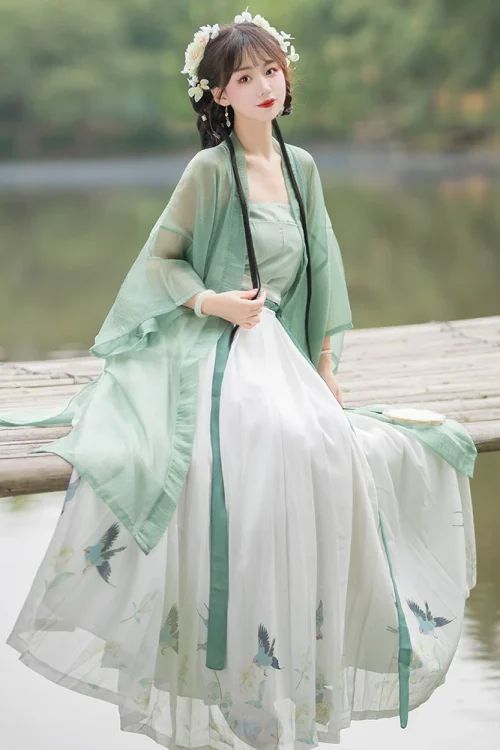The Allure of Hanfu: Unveiling the Timeless Elegance of Song Dynasty Fashion
The Song Dynasty, renowned for its cultural and artistic achievements, left an enduring legacy in the realm of fashion. The Hanfu, the pakaian tradisional Tiongkok, reached its zenith during this period, embodying the grace and simplicity that characterized the era.

Characteristics of Song Dynasty Hanfu
The Song Dynasty Hanfu was characterized by its flowing lines, elegant silhouettes, and subtle embellishments. Unlike the elaborate and ornate pakaian of previous dynasties, Song Hanfu embraced a more understated aesthetic, reflecting the refined tastes of the time. The use of soft, muted colors, such as celadon green, pale pink, and ivory, created a harmonious and ethereal effect.
Fabrics and Embroidery
The garments were typically made from fine fabrics, such as silk, linen, and cotton. Silk, in particular, was highly prized for its luxurious texture and drape. The fabrics were often adorned with intricate embroidery or woven patterns, adding a touch of elegance without overpowering the overall simplicity of the design.
Key Pieces of Hanfu
The Song Dynasty Hanfu consisted of several key pieces:
- Robe (Changpao): A long, loose-fitting garment that reached the ankles, typically worn over a skirt or trousers.
- Skirt (Qun): A wide, flowing garment that flared out from the waist, often pleated to create a graceful silhouette.
- Trousers (Ku): Wide-legged and loose-fitting, providing comfort and freedom of movement.
Aksesoris
The Song Dynasty Hanfu also included various accessories, such as:
- Belts: Used to cinch the waist and accentuate the figure.
- Scarves: Worn around the neck or draped over the shoulders, adding warmth and elegance.
- Headwear: Hats and hairpins completed the ensemble, adding a personal touch.
Lasting Influence
The grace and simplicity of the Song Dynasty Hanfu continue to inspire contemporary fashion designers and enthusiasts alike. Its timeless elegance and understated beauty have made it a symbol of Chinese cultural heritage and a source of inspiration for modern interpretations of traditional Chinese attire.
Embracing Simplicity: The Art of Minimalism in Song Dynasty Hanfu
The Song Dynasty (960-1279) marked a golden age in Chinese history, renowned for its cultural and artistic achievements. Among its many contributions, the Song Dynasty Hanfu style stands out as a testament to the era’s embrace of simplicity and elegance.

A Shift in Style
Hanfu, the traditional clothing of the Han Chinese, underwent significant changes during the Song Dynasty. The elaborate styles of previous dynasties gave way to a more refined and understated aesthetic, reflecting the Song Dynasty’s emphasis on Confucian values, which promoted modesty and restraint.
Key Features
The Song Dynasty Hanfu was characterized by:
- Clean lines and flowing silhouettes: Garments made from fine fabrics such as silk, cotton, and linen.
- Muted colors: Shades like white, gray, and blue replaced bright colors and excessive ornamentation, which were deemed inappropriate.
The Ruqun Ensemble
One of the most distinctive features of Song Dynasty Hanfu was the use of the “ruqun” (襦裙), a two-piece ensemble consisting of:
- Short jacket (Ru): Typically fitted and buttoned down the front.
- Long skirt (Qun): Gathered at the waist and falling gracefully to the ankles, allowing freedom of movement.
Accessories and Personal Style
Accessories played a significant role in enhancing the garments:
- Belts, scarves, and hair ornaments: Made from simple materials like wood, jade, or metal, designed to complement the garments without overpowering them.
Practicality and Comfort
The simplicity of Song Dynasty Hanfu extended beyond physical appearance. The loose-fitting silhouettes allowed for ease of movement, while the use of natural fabrics ensured breathability and comfort.
Kesimpulan
In conclusion, the Song Dynasty Hanfu style embodied the era’s embrace of simplicity and elegance. Through its clean lines, muted colors, and subtle embellishments, this style reflected Confucian values of modesty and restraint. The garments were not only aesthetically pleasing but also comfortable and practical, showcasing the enduring legacy of Song Dynasty culture.
The Cultural Significance of Hanfu: Exploring the Historical and Social Context of Song Dynasty Dress
The Song Dynasty (960-1279) marked a golden age in Chinese history, renowned for its cultural and artistic achievements. Among these, the Hanfu, the traditional Chinese attire, reached its zenith of elegance and refinement.

A Shift in Fashion Trends
The Song Dynasty witnessed a shift away from the elaborate and ornate styles of previous dynasties. Instead, the Hanfu embraced a more restrained and graceful aesthetic, characterized by:
- Clean lines and flowing silhouettes: Emphasizing comfort and breathability with natural fibers like silk and cotton.
Reflection of Values
The Song Dynasty Hanfu was not merely a fashion statement but a reflection of the era’s social and cultural values. The emphasis on simplicity mirrored Confucian ideals of moderation and self-cultivation. The Hanfu’s flowing lines and soft colors evoked a sense of tranquility and harmony with nature.
Distinctive Styles
- Women’s Hanfu: Consisted of a long, loose robe known as a ruqun, belted at the waist with wide, flowing sleeves.
- Hanfu Pria: Comprised a long gown called a changpao, worn over trousers, often adorned with subtle embroidery.
Hierarki Sosial
The Song Dynasty Hanfu also played a significant role in social hierarchy. The quality and style of one’s Hanfu indicated their social status, with elaborate embroidery and luxurious fabrics reserved for the elite, while simpler garments were worn by common people.
Enduring Legacy
The grace and simplicity of the Song Dynasty Hanfu have left an enduring legacy in Chinese culture, continuing to inspire contemporary fashion designers and often featured in historical dramas and cultural events. The Hanfu’s timeless elegance serves as a reminder of the era’s pursuit of harmony, refinement, and the beauty of simplicity.
